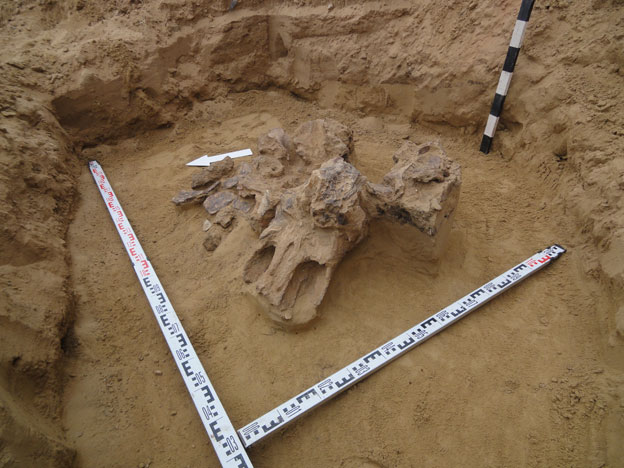Archaeology, especially prehistory, has always had strong scientific links with geology. Geological methods help archaeologists to obtain data on stratigraphy, palaeontology and geochronology, which makes it possible to reconstruct the palaeogeographical habitat conditions of early man.
We have already written that specialists of the Khoper Party from the Karpinsky Institute (https://t.me/karpinskyinstitute/537) led by Andrei Zastrozhnov, Head of the Department of Geomorphology and Quaternary Geology, take part in unique palaeontological expeditions in the Astrakhan Region, which result in no less unique archeological findings.
In the latest issue of the international journal Stratum plus. Archaeology and Cultural Anthropology, an article presents results of a study of an incomplete mammoth skeleton found in Quaternary sediments in the Astrakhan Region. It is believed that some of the bones show traces of ancient human influence and signs of hunting activity, which makes it possible to shift the lower limit of human appearance within the territory of the contemporary Astrakhan Region to at least 100-130 kyr. Previously, it was assumed that man appeared in this area only 12-14 thousand years ago. Without a comprehensive geological study of Quaternary sediments of the region by our specialists, such conclusions would be impossible.
In July 2021, near the village of Lenino, Astrakhan Region, on the bank of the Enotaevka River, a palaeontological expedition of the Astrakhan Museum-Reserve led by M.V. Golovachev discovered remains of the right and left femur bones and fragments of a mammoth scapula, presumably belonging to one individual. A prospect pit at the site confirmed the assumption of the possible presence of remains of an ancient elephant skeleton in this place.
Excavations were carried out over two field seasons. The work was complicated by the location of the skeletal remains at the base of a 15-m high scarp slope in fine-grained sand layer. The work was performed by the Astrakhan Museum-Reserve together with the Khoper Geological Party of the Karpinsky Institute, which was responsible for geological and stratigraphic studies of the site.
In total, geologists, palaeontologists, archaeologists, radiologists and trace specialists from St. Petersburg, Volgograd, Ufa, Rostov-on-Don, Moscow and Astrakhan took part in the studies.
During the two years of work, 36 bones and their fragments were found, and samples were taken for granulometry, palynology, malacofauna and absolute geochronology. Some of the geochronological samples were analysed in the OSL laboratory of the Karpinsky Institute. The studies confirmed the continental origin of the bone-bearing sand layers and that they are confined to sediments of the Singilian regression of the Caspian Sea (100-130 kyr).
The study of the skeletal remains showed that they belonged to an adult female Mammuthus cf. intermedius, 35 to 40 years old. At the same time, desktop clearing revealed probable traces of ancient human impact, some of which were further confirmed as man-made by traceological studies. A CT scan of a non-penetrating conical hole in the body of a thoracic vertebra showed the presence of a fragment of a foreign object inside the hole, which allowed this damage to be interpreted as a wound channel. This suggests that the animal was probably hunted by ancient man. Some of the bones could have been used to make tools.
This is probably the oldest evidence of hunting and tool-making activities of ancient man in the Middle and Lower Volga. Thus, the joint efforts of geologists, palaeontologists and archaeologists have expanded our knowledge of the ancient history of this region and the behaviour of the ancient people who lived here many thousands of years ago.
